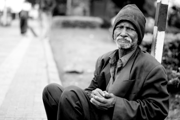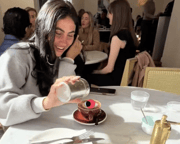
In the heart of Sydney's CBD, beneath towering office blocks, a small group of men had built an unexpected community.
The streets were their home, but not out of necessity.
They claimed to have chosen this life—and in doing so, challenged every assumption about what it meant to be homeless.
For David, a 52-year-old former civil construction worker from New Zealand, Sydney's pavements had been home for five years.
'We're out here because we choose it. It's not about money—I could get somewhere if I wanted. But I've got a better sense of community here than I ever did back home.'
The encampment, only six months old, had become a tightly knit neighbourhood, complete with improvised shelters and house rules.
Residents insisted it remained strictly male-only, arguing that women brought 'drama' to their carefully managed community.
Charles, who declined to be photographed, had created the camp's most remarkable dwelling—a 'cube hut' made from stacked bread crates, decorated with Chinese lanterns, blankets, and pillows.
It was a striking example of how comfort and dignity could be carved out even in the harshest conditions.
The men were open about their drug use and philosophical approach to homelessness.
Some admitted they preferred spending their money on substances rather than rent.
'I spend it on what I actually want,' one man said candidly.
Yet beneath their bravado, familiar struggles were evident.
David’s path to the streets began when COVID-19 halted his construction career.
Jack, another long-term resident, spoke of a broken relationship, with his partner and child living in North Sydney while he remained on the streets.
The camp functioned with a loose support system—the nearby convenience store allowed device charging, and The Station drop-in centre provided meals, showers, and laundry services.
According to David, local authorities had been 'respectful', occasionally asking them to 'condense things' but largely leaving them alone.
Understanding Australia's homelessness crisis
Only 6 per cent of Australia's homeless population slept rough on the streets.
The majority were 'hidden homeless'—people sleeping in cars, couch surfing, or staying temporarily with others.
These Australians may have shelter but no permanent place to call home.
David and his companions represented voluntary homelessness, but they were part of a much larger national crisis.
Housing affordability stress had increased by 36 per cent in the three years to 2023-24.
One in seven people experiencing homelessness were over 55 years old, with the fastest-growing cohorts aged 55-64 (up 15 per cent) and 65+ (up 31 per cent).
Median rents had surged 51 per cent since the COVID-19 pandemic, while the proportion of employed people accessing homelessness services rose from 10.9 per cent to 15.3 per cent between 2018 and 2023.
'Homelessness is no longer confined to the most vulnerable. With the housing crisis forcing working families into homelessness, this should be a wake-up call for action,' said Homelessness Australia CEO Kate Colvin.
Despite claiming choice, the York Street residents faced the same challenges as other rough sleepers—poor nutrition, dental issues, mental health conditions, and barriers to healthcare.
Their camp highlighted the lack of privacy and basic amenities most Australians take for granted.
Key facts about homelessness in Australia
- 122,000+ people experienced homelessness on any given night.
- Only 6 per cent were visible rough sleepers—94 per cent were 'hidden homeless'.
- One in seven homeless people were over 55 years old.
- Rough sleeping increased 22 per cent nationally, 51 per cent in NSW since 2020.
- Domestic violence remained one of the main drivers of homelessness.
The Station drop-in centre represented one of thousands of specialist homelessness services across Australia.
In 2023-24, about 280,000 clients were assisted, with 80.9 per cent of clients at risk of homelessness successfully avoiding it.
Services ranged from emergency accommodation to job training, proving that homelessness could be temporary.
However, around 14,700 clients returned to homelessness after a period of secure housing in 2022-23, highlighting ongoing systemic challenges.
The York Street camp challenged assumptions about homelessness but also revealed deeper issues—trauma, relationship breakdowns, job losses, and substance dependency.
Their 'neighbourhood' was a testament to resilience and a reminder of systemic failures.
Nearly a third of Australians earning under $100,000 were concerned about becoming homeless within 12 months, making these men’s stories more relatable than many would like to admit.
For now, the unconventional community remained in Sydney's heart—a daily reminder of the housing crisis affecting all Australians and proof that people could still create connection and meaning in adversity.
What This Means For You
Over 122,000 Australians experience homelessness on any given night, yet only six per cent sleep rough, with the majority remaining hidden in temporary or unstable accommodation.
Housing affordability stress and rising rents have become major drivers of homelessness, particularly affecting older Australians who may be living on fixed incomes or facing unexpected financial pressures.
Specialist services like The Station provide essential support to tens of thousands each year, but some clients inevitably return to homelessness, highlighting ongoing systemic challenges.
The stories of voluntary rough sleepers, such as those at York Street, demonstrate remarkable human resilience, yet they also reveal underlying trauma, relationship breakdowns, and substance use issues.
For older Australians, these realities may feel closer than expected—many in this age group worry about financial security and the possibility of losing their homes, making these stories not just news, but a warning and a call to consider what steps communities and individuals can take to ensure safety and stability in later life.
Homelessness and homelessness services—Australian Institute of Health and Welfare — Provides national data on homelessness, including the number of people experiencing homelessness and demographic breakdowns.
https://www.aihw.gov.au/reports/australias-welfare/homelessness-and-homelessness-services
Homelessness | Australian Bureau of Statistics — Offers 2021 Census data showing the scale of homelessness in Australia.
https://www.abs.gov.au/statistics/m...ers-themes-and-indicators/secure/homelessness
Rough sleeping surges as homelessness crisis worsens: New report – Homelessness Australia — Reports a 22 per cent national increase in rough sleeping and 51 per cent increase in NSW since 2020.
https://homelessnessaustralia.org.a...es-as-homelessness-crisis-worsens-new-report/
Homelessness in Australia Statistics | Mission Australia — Highlights that only 6 per cent of homeless Australians sleep rough.
https://www.missionaustralia.com.au...lessness/homelessness-in-australia-statistics
Homelessness in Australia Statistics | Mission Australia — Confirms that 6 per cent of homeless people sleep on the streets.
https://www.missionaustralia.com.au...lessness/homelessness-in-australia-statistics
Homelessness in Australia Statistics | Mission Australia — Describes ‘hidden homelessness,’ including couch surfing, sleeping in cars, and temporary stays.
https://www.missionaustralia.com.au...lessness/homelessness-in-australia-statistics
Rough sleeping surges as homelessness crisis worsens: New report – Homelessness Australia — Notes that housing affordability stress has increased 36 per cent in three years, driving homelessness.
https://homelessnessaustralia.org.a...es-as-homelessness-crisis-worsens-new-report/
Homelessness in Australia Statistics | Mission Australia — States that one in seven people experiencing homelessness are over 55 years old.
https://www.missionaustralia.com.au...lessness/homelessness-in-australia-statistics
Estimating Homelessness: Census, 2021 | Australian Bureau of Statistics — Provides age-specific data showing 15.8 per cent of homeless people are 55 and older.
https://www.abs.gov.au/statistics/people/housing/estimating-homelessness-census/latest-release
Rough sleeping surges as homelessness crisis worsens: New report – Homelessness Australia — Reports a 51 per cent increase in median rents since COVID-19.
https://homelessnessaustralia.org.a...es-as-homelessness-crisis-worsens-new-report/
Rough sleeping surges as homelessness crisis worsens: New report – Homelessness Australia — CEO Kate Colvin warns that homelessness now affects working families, not just the most vulnerable.
https://homelessnessaustralia.org.a...es-as-homelessness-crisis-worsens-new-report/
Homelessness Australia: Statistics & Facts | The Salvation Army Australia — Notes health impacts of homelessness including poor nutrition and mental health challenges.
https://www.salvationarmy.org.au/ne...es/homelessness-week/homelessness-statistics/
Homelessness in Australia Statistics | Mission Australia — Identifies domestic violence as a major driver of homelessness.
https://www.missionaustralia.com.au...lessness/homelessness-in-australia-statistics
Homelessness and homelessness services—Australian Institute of Health and Welfare — Reports that 280,000 clients were assisted by homelessness services in 2023-24.
https://www.aihw.gov.au/reports/australias-welfare/homelessness-and-homelessness-services
G Housing and homelessness—Report on Government Services 2025—Productivity Commission — States that 80.9 per cent of clients at risk of homelessness successfully avoided it in 2023-24.
https://www.pc.gov.au/ongoing/report-on-government-services/2025/housing-and-homelessness
Homelessness Australia: Statistics & Facts | The Salvation Army Australia — Reports that 14,700 clients returned to homelessness after secure housing in 2022-23.
https://www.salvationarmy.org.au/ne...es/homelessness-week/homelessness-statistics/
Homelessness Australia: Statistics & Facts | The Salvation Army Australia — Notes that nearly a third of people earning under $100,000 are concerned about becoming homeless within 12 months.
https://www.salvationarmy.org.au/ne...es/homelessness-week/homelessness-statistics/
What are communities willing to do to ensure that everyone, regardless of age or circumstance, has a safe place to call home?







